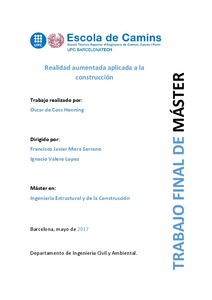Mostra el registre d'ítem simple
Realidad aumentada aplicada a la construcción
| dc.contributor | Mora Serrano, Javier |
| dc.contributor | Valero López, Ignacio |
| dc.contributor.author | Coss Henning, Oscar de |
| dc.contributor.other | Universitat Politècnica de Catalunya. Departament d'Enginyeria Civil i Ambiental |
| dc.date.accessioned | 2017-06-20T10:28:08Z |
| dc.date.available | 2017-06-20T10:28:08Z |
| dc.date.issued | 2017-05 |
| dc.identifier.uri | http://hdl.handle.net/2117/105654 |
| dc.description.abstract | La Realidad Aumentada (RA) es una tecnología que se abre campo dentro de la construcción al conciliar el mundo físico y el digital, este novedoso método ha permitido enfrentarse mejor uno de los mayores retos a los que se enfrentan ingenieros y arquitectos: ver cómo quedará su obra en el mundo real y a la escala adecuada. De esta forma, es mucho más fácil que estos profesionales tomen decisiones rápidamente. Su utilización es muy sencilla y requiere de pocos elementos para poder implantarla. Lo único que se necesita es tener una cámara capaz de captar la realidad e información a tiempo real. Junto con la cámara, un segundo elemento es el marcador, el cual es el responsable de iniciar la secuencia de Realidad Aumentada a partir de un punto geográfico captado con la cámara. Para lograr la conciliación de esta tecnología es necesario contar con una herramienta BIM, un motor de realidad virtual y un SDK¹ de realidad aumentada, que para este estudio se utilizaron los softwares Revit, Unity y Vuforia respectivamente. En cuanto equipos usados para su interacción se encuentran un Portátil, Cardboard, HTC Vive, Tablet, y Microsoft HoloLens. Para describir el flujo de trabajo y conseguir el objetivo, se ha optado por dividir en dos casos de uso: el primero para familiarización del software a utilizar, explorando las posibilidades del recorrido virtual para la mejora en la planificación de obra. El segundo caso se centra en las posibilidades de la Realidad Aumentada que se presentan dentro del sector AEC (Architecture, Engineer and Construction), mediante la creación de una aplicación y el uso de las gafas Microsoft HoloLens. |
| dc.description.abstract | The Augmented Reality is a technology which provides the possibility of interaction within the construction industry between two different worlds: physical and digital. This novel method could be the key to solving one of the most long-standing issues of engineers and architects: the ability to see the designed project in the real world and scale before its execution what will facilitate the decision-making of the most crucial questions of the projects. The application of above mentioned technology is quite easy to use and does not require a lot of tools to achieve the significant results. Necessary devices for the effective implementation are: camera which is able to perceive the information in real time and the target. This target is nothing but the drawing which activates the real-time visualization of the previously designed project. However, it should be highlighted that the project must be developed by using the following software: program for building information modeling (BIM), game engine and a software development kit (SDK or devkit). For this study Revit, Unity and Vuforia have been respectively applied what gives rise to the necessity of the appropriate equipment, such as: Laptop, Cardboard, HTC Vive, Tablet, and Microsoft HoloLens. To present the information in more detail, it has been decided to divide the study into two parts. The first one submits the general overview that have been provided with the demonstration of the virtual tour possibilities which leads to improvements of project management. The second part is focused on potential of The Augmented Reality within the construction industry. For this purpose, the special application has been developed which provides virtual immersion to visualize the project through Microsoft HoloLens. |
| dc.language.iso | spa |
| dc.publisher | Universitat Politècnica de Catalunya |
| dc.rights | Attribution-NonCommercial-NoDerivs 3.0 Spain |
| dc.rights.uri | http://creativecommons.org/licenses/by-nc-nd/3.0/es/ |
| dc.subject | Àrees temàtiques de la UPC::Enginyeria civil |
| dc.subject.lcsh | Virtual reality |
| dc.subject.lcsh | Augmented reality |
| dc.subject.other | BIM |
| dc.subject.other | Microsoft HoloLens |
| dc.title | Realidad aumentada aplicada a la construcción |
| dc.type | Master thesis |
| dc.subject.lemac | Realitat virtual |
| dc.subject.lemac | Realitat augmentada |
| dc.identifier.slug | PRISMA-124553 |
| dc.rights.access | Open Access |
| dc.date.updated | 2017-05-24T18:00:19Z |
| dc.audience.educationlevel | Màster |
| dc.audience.mediator | Escola Tècnica Superior d'Enginyers de Camins, Canals i Ports de Barcelona |
| dc.audience.degree | MÀSTER UNIVERSITARI EN ENGINYERIA ESTRUCTURAL I DE LA CONSTRUCCIÓ (Pla 2015) |



